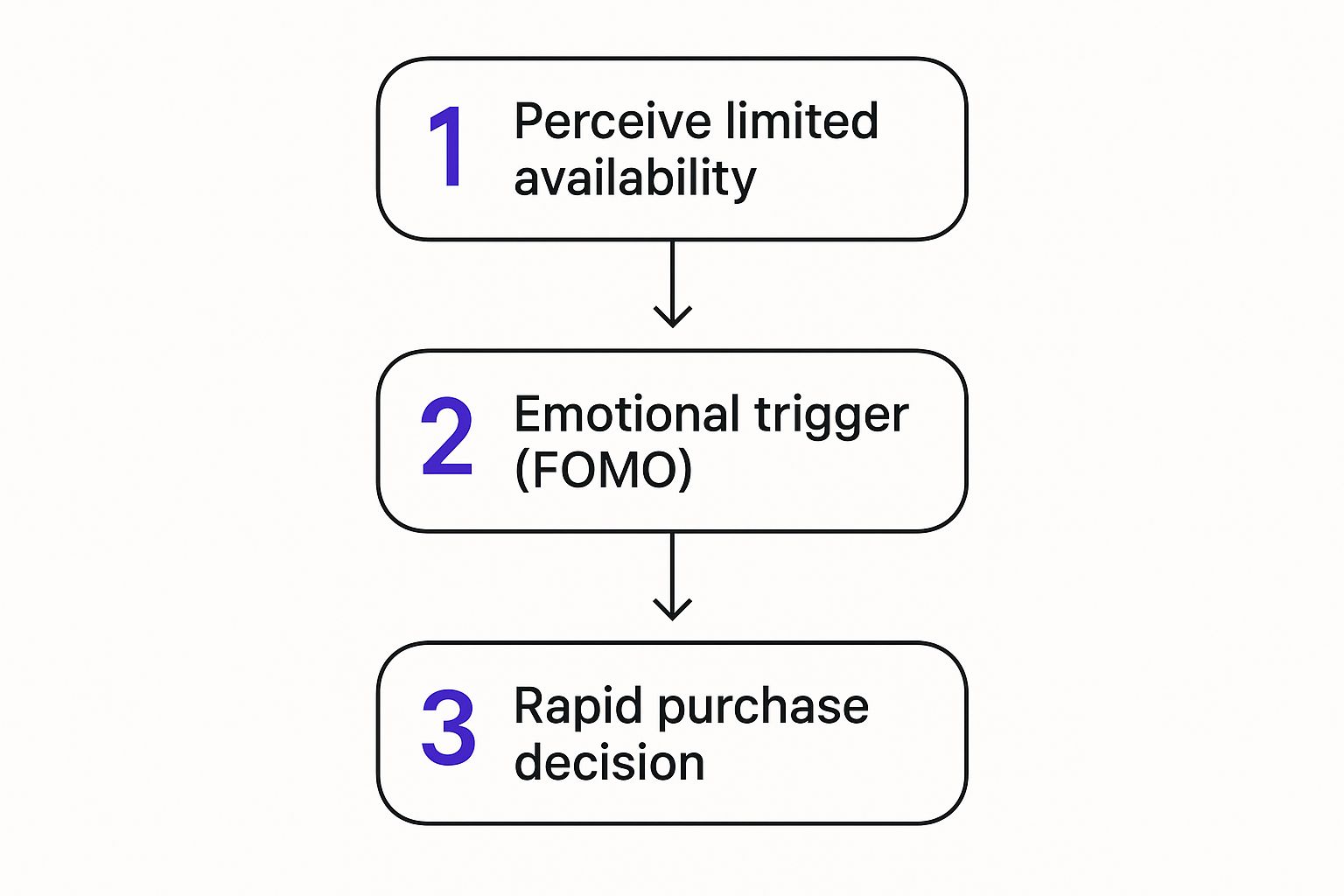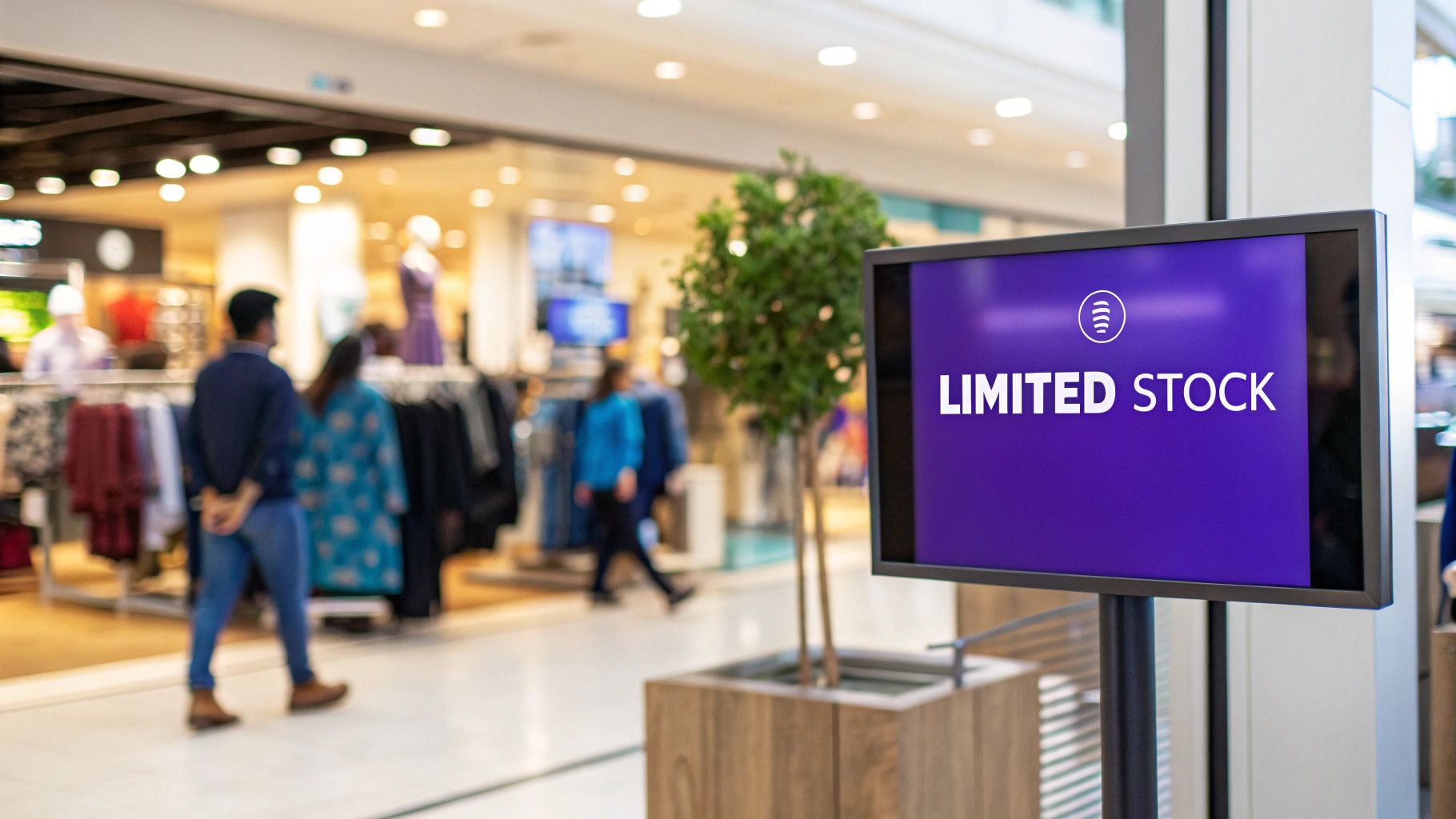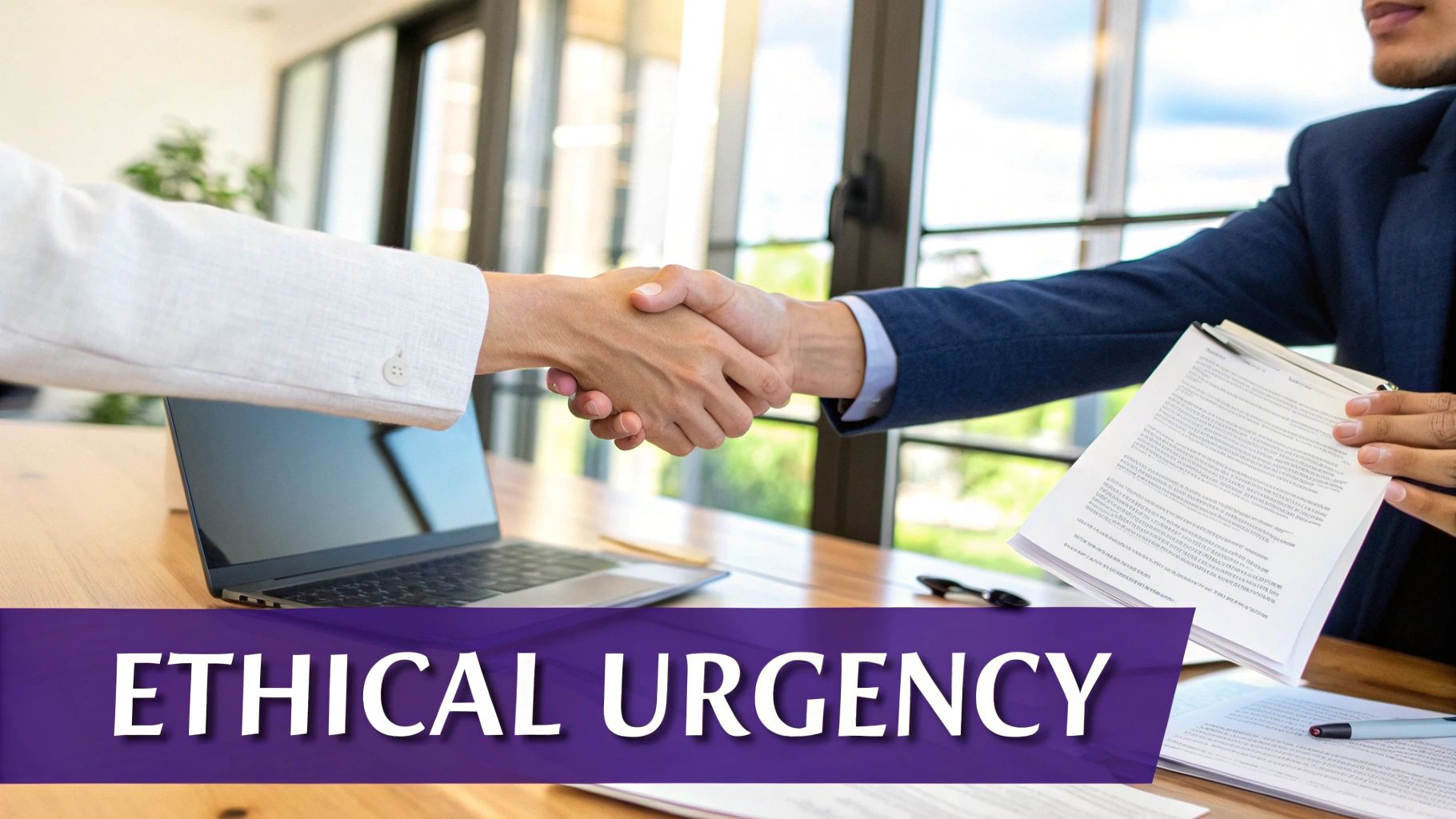When you're trying to create urgency in a sales conversation, you're really just tapping into some fundamental human psychology. It’s about signaling that an offer is limited—either by time or by quantity—which motivates people to make a decision now instead of putting it off.
To get this right, you first have to understand what makes people tick. At its core, creating urgency isn’t about being pushy or aggressive. It's about aligning your sales process with how people naturally think and make decisions.
When a prospect feels like an opportunity might slip through their fingers, their brain automatically assigns more value to it. This isn't some sales trick; it's just how we're wired to assess risk and reward.
Two main psychological drivers are at play here:
This simple flowchart breaks down how these triggers push someone toward a buying decision.

As you can see, a perceived limitation kicks off an emotional response, which is what really lights a fire under the final decision.
Knowing the psychology is one thing; using it without sounding like a sleazy salesperson is another. The best brands have mastered this by framing urgency as genuinely helpful information.
Think about Amazon's "Only 2 left in stock" alert. It’s not an aggressive command. It’s just a piece of data that helps you, the customer, make an informed choice. It respects your intelligence while giving you a gentle nudge.
Effective urgency frames a quick decision as a benefit to the customer, not just a win for the salesperson. It answers the question, "Why should I act on this right now?" with a clear, value-driven reason.
It’s so important to get this right. To dig a little deeper into how to motivate people ethically, check out this great read on the power and pitfalls of fear-based marketing. When you build your sales strategy on this foundation, you can encourage prospects to move forward in a way that actually builds trust.

Scarcity is one of the oldest and most powerful tools in any salesperson's kit. It’s pretty simple: when something is in short supply, people want it more. This isn't about manufacturing fake pressure. It’s about being upfront about genuine limitations to help a prospect who’s on the fence make a decision that's in their best interest.
You can frame scarcity in two main ways: by highlighting a limited quantity or by setting a deadline. Both tap into that universal fear of missing out (FOMO), but they work best in different scenarios. The key is picking the right approach based on what you’re selling, your business model, and what your customers will respond to.
When you're dealing with physical products or anything with a finite inventory, quantity-based scarcity is your go-to. It sends a clear signal: if you wait, this might be gone for good. It's so effective because the concept is concrete and easy for anyone to grasp.
You see this all the time, and for good reason. Here are a few ways to put it into practice:
These tactics aren't just theory. Retailers like Decathlon have mastered this by showing real-time stock levels. When a customer sees an item is almost sold out, it reinforces the idea that it's a popular and valuable product, pushing them to buy before it's too late. If you want to see more real-world examples, you can explore how to master urgency for sales events on choco-up.com.
Time-based scarcity works by setting a clear deadline. This is the perfect strategy for sales promotions, new product launches, or seasonal campaigns. Think about it—even an amazing discount loses its punch if the customer thinks they can get it anytime. There's simply no reason to act now.
By giving your offer a clear expiration date, you provide a compelling reason for prospects to prioritize their decision. It transforms a "maybe later" into a "yes now."
Some of the most effective time-based tactics include:
A software company, for example, might offer a 20% discount on its annual plan, but only for the next 48 hours. This gets leads who were already on the fence to finally pull the trigger. The secret, though, is that the deadline has to be real. If you keep extending your "final day" of the sale, you'll lose all credibility. Knowing how to create urgency in sales ethically means sticking to your word.
Deciding between scarcity and time-based urgency isn't always obvious. It depends on what you're selling and the kind of action you want to drive. This table breaks down the core differences to help you choose the right tactic for the right situation.
Ultimately, both paths lead to the same destination: encouraging a timely decision. The best sales professionals often find ways to combine both, creating a powerful one-two punch that respects the customer while clearly communicating the value of acting sooner rather than later.

Let's be honest: urgency isn't a magic wand you can wave over every single lead. If you try to create a fire-sale panic for someone who just stumbled onto your site, you'll come off as desperate, not persuasive. It's like trying to fuel a race car with regular gasoline—it just won't work.
The real secret to making urgency a powerful sales tool is knowing exactly when and with whom to use it. You have to focus your energy on high-intent buyers—the people who are already leaning in, signaling they’re close to making a move.
This isn't about a "spray and pray" approach. It's about delivering a well-timed nudge to someone who is already on the fence. By doing this, you avoid burning out your audience with constant "last chance" offers that eventually just become noise.
The trick is to learn how to spot the digital breadcrumbs that separate the casual browsers from the serious buyers. Once you’ve pinpointed them, the next step is a big one: properly understanding their needs and timing. A big part of this is qualifying sales leads effectively so you know your efforts are hitting the right mark.
So, who are these high-intent buyers? They aren't just random visitors. They’re the people whose actions are screaming, "I'm interested!" They've moved past idle curiosity and are actively considering a purchase.
You can usually spot them by segmenting your audience based on specific actions. Think of these as different levels of readiness:
By zeroing in on these specific groups, you can stop sending generic blasts and start crafting messages that speak directly to where they are in their buying journey.
Targeting the right audience is crucial. Urgency tactics fall flat if the person isn't already interested. Research consistently shows that these strategies work best on high-intent buyers who already have a baseline interest in what you're selling.
Once you've grouped these prospects, you can hit them with urgency triggers that feel helpful and relevant, not aggressive or random. This is how you build momentum without eroding trust.
It's all about matching the message to the action.
For that cart abandoner, a simple email like, "Your items are selling fast! Complete your order before they're gone" can be incredibly effective. It's a direct, helpful nudge.
But for the repeat product viewer, you need a slightly different angle. Something like, "We noticed you're interested in [Product Name]. Just a heads-up, a special offer on this item ends in 24 hours." This approach acknowledges their interest and gives them a clear, time-sensitive reason to act now.
This kind of strategic focus ensures your urgency tactics land with maximum impact, turning warm leads into closed deals.
Creating urgency in a complex B2B sale is a different beast altogether. This isn't B2C, where a countdown timer might push someone to buy a pair of sneakers. You can't just slap a "limited time" banner on a six-figure deal and expect results.
The sales cycles here are long, the stakes are sky-high, and you're almost always juggling a whole committee of decision-makers.
The entire strategy shifts. Forget about creating immediate pressure and think more about building a rock-solid business case for why they need to act now. It’s less about FOMO and much more about spelling out the real, tangible cost of inaction. Your job is to patiently show them why waiting is the far more expensive and risky choice.
It's a tricky balance of speed and patience. In these complex deals, one survey found that while 65% of sales managers say building urgency is a priority, the average deal over $35,000 involves six to ten decision-makers and takes more than five calls to close. Creating urgency in that environment means you're methodically communicating value over a long period, not just on the final call. You can dive deeper into this dynamic by learning more about the roles of urgency and patience in consultative selling.
Instead of pulling arbitrary deadlines out of thin air, tie your timeline directly to the client’s actual business objectives. This is a consultative move that instantly changes your role from "person selling something" to "strategic partner who gets it."
You're no longer pushing your agenda; you're aligning with theirs.
This could mean linking your proposal to things already on their calendar:
For example, try saying something like, "I know your big product launch is in Q3. To make sure we have the new CRM fully implemented and your team trained well ahead of that, we really need to get the agreement finalized by the end of this month." See the difference? That's not a pushy sales tactic; it’s just smart project management.
In B2B sales, urgency isn’t about pushing a product. It's about pulling a project forward to meet a critical business deadline. The focus is on their timeline, not yours.
When you frame it this way, your solution becomes a key part of their success, and the decision to move forward feels like a shared goal.
Let’s be honest: B2B decision-makers live and die by the numbers. They’re driven by ROI. The single most powerful way to create real urgency is to make it painfully obvious what they stand to lose by waiting.
Don’t just talk about the benefits of your solution; calculate the actual price of their delay.
You have to put a dollar figure on their current pain points. Get specific.
On Lost Revenue: "Based on the conversion rates you shared, every month you delay implementing this lead-nurturing software is costing you an estimated $15,000 in potential new business."
On Wasted Resources: "Your team is spending a combined 80 hours a week on manual data entry. Our platform automates all of that. Just this month alone, delaying means you're losing another 320 hours of productivity."
On Missed Opportunities: "I saw that your top competitor just adopted a similar technology. Waiting even three months could put you at a serious disadvantage and mean losing market share."
Presenting the problem in these concrete, financial terms completely changes the conversation. It shifts from "Should we buy this?" to "How fast can we stop hemorrhaging money?" This reframes your solution as an essential business move to stop the bleeding, not just another line-item expense.
When you can prove that doing nothing is the most expensive choice they can make, genuine urgency just naturally follows.

There’s a razor-thin line between creating helpful urgency and just being pushy. If you cross it, you don't just lose a sale—you torch your credibility, and that's something you can't easily buy back.
Ethical urgency isn’t about tricking someone into a decision they’ll regret. It’s about giving them clear, truthful information that helps them act in their own best interest. Think of yourself as a helpful guide, not a high-pressure closer.
This means every claim you make has to be grounded in reality. If you say a discount ends Friday, it actually has to end Friday. If you say there are only three spots left in your program, there really are only three spots left. Honesty is everything here.
This is what separates sustainable, long-term growth from those cheap, short-term wins that ultimately tarnish your reputation. Remember, a single negative review detailing a manipulative experience can easily wipe out the goodwill from ten positive ones.
To stay on the right side of that line, everything you do has to be built on a foundation of honesty and real value. It all comes down to transparency.
When you’re upfront about why there's urgency—whether it’s a genuine inventory constraint or a planned price increase—it feels less like a sales tactic and more like you're giving them a helpful heads-up.
This whole approach demands that you put the customer's needs first. Is this offer genuinely a good fit for them? Does acting now truly benefit them in a meaningful way? If the answer is yes, then creating a sense of urgency is just good service.
"True urgency comes from a place of value. It's about confidently showing a prospect why the cost of inaction is greater than the cost of your solution, and why waiting will only amplify that cost."
Framing it this way shifts the entire dynamic. You're no longer just trying to hit a number; you're helping them avoid a future headache or seize a fleeting opportunity.
Seeing the difference in action makes it crystal clear. Here’s a simple breakdown of what separates a helpful nudge from a manipulative shove.
Ethical Urgency (The Dos):
Manipulative Tactics (The Don'ts):
Learning how to create urgency in sales ethically means you're playing the long game. You’re building relationships, not just chasing quotas. Root your strategy in honesty and respect, and you'll build a powerful sales engine that drives real growth and creates customers who actually trust you.
Even with the best game plan, you're going to have questions when you start putting these urgency tactics into practice. It's one thing to talk about it, but another to do it right without coming off the wrong way. Let's tackle some of the most common hurdles I see sales pros run into.
This is probably the number one fear I hear, and it's a valid one. But the short answer is no—not if you do it right. The entire strategy hinges on making sure the urgency is rooted in real, genuine value.
When you're transparent about why there's a time limit, it feels like you're giving the buyer a helpful heads-up, not a desperate sales pitch.
Think about it. Saying something like, "To make sure every new client gets the attention they deserve, our onboarding team can only take on five new accounts this month," is a completely believable and value-driven reason. It positions your service as high-quality and in-demand.
What you absolutely must avoid is faking it. Constant "last chance" sales or made-up scarcity will kill your credibility. Customers are smart; they'll catch on, and your brand's reputation will take a serious hit.
There's no magic number here, but think of urgency like a spice—a little bit adds a lot of flavor, but too much ruins the dish. If you're constantly yelling "act now," your audience will just tune you out. It becomes background noise.
The best approach is to tie your urgency tactics to specific, legitimate events. This makes them feel special and important.
And for those automated tactics, like a low-stock alert on your website, just make sure it’s hooked up to your actual inventory data. The goal is for urgency to feel like a noteworthy event, not a daily pressure tactic.
Vague, cliché phrases like "Don't Miss Out!" are dead on arrival. They get ignored because they don't give the reader any real information. Your subject line needs to be specific, clear, and instantly show the value.
The winning formula is simple: combine the benefit with a clear limitation (like a deadline or scarcity).
This creates a compelling reason to open the email right now without sounding like spam.
Here are a few examples that work well:
See the difference? Each one tells the reader exactly what they're about to lose and when. That kind of clarity is what cuts through a crowded inbox and gets people to click.
Ready to turn more of your leads into actual meetings? Upcraft provides conversational AI agents that can engage your prospects, warm up cold leads, and book appointments five times more effectively than old-school outreach. Free up your team and let the pipeline fill itself.
Enter your contact information and Archer will start a conversation with you via text message.